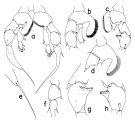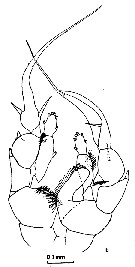|
|
 |
Fiche d'espèce de Copépode |
|
|
Calanoida ( Ordre ) |
|
|
|
Arietelloidea ( Superfamille ) |
|
|
|
Heterorhabdidae ( Famille ) |
|
|
|
Heterorhabdus ( Genre ) |
|
|
| |
Heterorhabdus pacificus Brodsky, 1950 (F,M) | |
| | | | | | | Syn.: | Heterorhabdus vicinus Tanaka, 1953 (p.134);
Heterorhabdus (Heterorhabdus) pacificus : Bradford-Grieve,1999 b (p.81, figs.F,M, Rem., figs.174, 191) | | | | Ref.: | | | Brodsky, 1950 (1967) (p.355, figs.F,M, Rem.); Tanaka, 1964 a (p.4, figs.F,M, Rem.); Vaupel-Klein, 1970 (p.38, figs.F); Bradford, 1971 a (p.128, fig.M); Kos, 1976 (Vol. II, figs.F, M, Rem.); Nishida & Ohtsuka, 1996 (p.620); Chihara & Murano, 1997 (p.818, Pl.119,121: F,M); Park, 2000 (p.135, figs.F,M, Rem.) |  issued from : T. Park in Bull. Scripps Inst. Oceanogr. Univ. California, San Diego, 2000, 31. [p.260, Fig.108]. Female: a, habitus (left side); b, urosome (dorsal); c, d, forehead (left, dorsal, respectively); e, f, genital somite (ventral, left, respectively); g, left Mx2 (posterior); h, P5 (anterior); i, exopod of P5 (posterior). Nota: Mx2: 2nd seta of 1st lobe less than 1/2 length of 1st spine; spine of 2nd lobe relatively thin; posterior subterminal spine of 4th lobe 40% as long as 2nd saberlike spine; falcate spine of 5th lobe about 1.2 times length of saberlike spine, with about 1/2 of medial margin serrated with spinules: falcate spine of 6yj lobe with about 68% of medialmargin serrated with spinules.
|
 issued from : T. Park in Bull. Scripps Inst. Oceanogr. Univ. California, San Diego, 2000, 31. [p.261, Fig.109]. Male: a, P5 (anterior); b, right P5 (distal segments of rami omitted), anterior; c, idem (posterior); d, basipod of right P5 (anterior); e, distal end of exopod of right P5 (lateral); f, exopod of left P5 (anterior); g, h, second exopodal segment of right P5 (anterior, posterior, respectively).
|
 issued from : J.M. Bradford-Grieve in The Marine Fauna of New Zealand: Pelagic Calanoid Copepoda. National Institute of Water and Atmospheric Research (NIWA). NIWA Biodiversity Memoir, 111, 1999. [p.82, Fig.49]. Female: A, urosome (dorsal); B, genital somite (left lateral side); C, lobe 4 of Mx2. Male: D, P5 (L = left leg; R = right leg).
|
 issued from : O. Tanaka in Publs Seto Mar. Biol. Lab., 1964, XII (1). [p.5, Fig.176]. Female: a, habitus (dorsal); b, last thoracic segment and genital somite (lateral left side); c, idem (other specimen); d, idem (ventral); e, Mxp; f, curved spine on the 2nd basal segment of P1; g, P5. Nota: The urosome segments and furca are in the proportional lengths as 47:14:10:8:21 (right) = 100. The genital somite slightly asymmetrical.A1 exceeds the end of the furca by 2 terminal segments. Male: h, P5; i, urosome (dorsal). Nota: The urosome segments and furca are in the proportional lengths as 21:17:15:13:6:28 = 100. A1 exceeds the end of the furca by one terminal segment.
|
 Issued from : J.C. von Vaupel-Klein in Zool. Verh. Leiden, 1970, 110. [p.32, Fig.15,a-c]. Female: a, genital complex (lateral right side); b, left Md (chewing plate); c, right Md (chewing plate). Nota: The specimens shows differences in the structure of the chewing plates; Brodsky described the mandibles of the females as \"symmetrical, except for the number of teeth\". In our specimens the number of teeth is 2 on the left mandible and 3 on that of the right mandible. The caudal margins of the urosomal somites have serrated edges, but not mentioned by Brodsky (1950).
|
 Issued from : K.A. Brodskii in Calanoida of the Far Eastern Seas and Polar Basin of the USSR. Opred. Fauna SSSR, 1950, 35 (Israel Program for Scientific Translations, Jerusalem, 1967) [p.355, Fig.250]. Female (from NW Pacific): habitus (dorsal and lateral right side); M Ri, Md (bitting edge, right side view); urosome (lateral left side) ; S5, P5. Male: S5, P5. Nota male: Uroso slightly less than half length of cephalothorax. Left A1 geniculate, slightly exceeding body length. Basis of right P5 bearing large curved process with wide rounded apex. 2nd segment of exopodite of right P5 bearing triangular process situated at the very proximal part of the segment. Distal segments of exopodites bearing long thin apical bristles, bristle of right leg straight, almost as long as the segment, bristle of left leg almost as long as the entire leg.
|
 issued from : J.M. Bradford in N.Z. Jl mar. freshw. Res., 1971, 5 (1). [p.128, Fig.7, b]. Male: b, P5.
|
 Heterorhabdus pacificus Heterorhabdus pacificus female: 1 - See key to species groups of Heterorhabdus: ''abyssalis'' Group (p.90, 114). 2 - Genital somite without a conical projection mediodorsally (Fig.108- a, f). 3 - Laterally, genital somite without a tubercular outgrowth posteriorly on dorsal margin (Fig.108-a). 4 - Laterally, genital operculum far short of reaching posterior end of somite (Fig.108-f). 5 - Laterally, right and left genital flanges symmetrical. 6 - Laterally, genital prominence distinctly separate from ventral wall of somite (Fig.108-f). 7 - Dorsally, as well as ventrally, lateral swellings of genital somite reaching posterior end of somite (Fig.-108b). 8 - Laterally, genital prominence extending close to posterior end of somite; genital somite with a conspicuous dorsal hump (Fig.108-f).
|
 Heterorhabdus pacificus Heterorhabdus pacificus male: 1 - See key to species groups of Heterorhabdus: ''abyssalis'' Group (p.90, 114). 2 - Basis of left P5 without a well-developed inner lobe (Fig.109-a). 3 - Basal inner lobe of right P5 armed with normal bristles (Fig.109-b, c). 4 - 3rd exopodal segment of right P5 with a short terminal lobe, less than 1/3 length of terminal spine (Fig.109- e). 5 - Basal lobe of right P5 arising from anteromedial side of segment (Fig.109-a). 6 - 2nd exopodal segment of left P5 with outer spine not borne on a conical process (Fig.109-a, f). 7 - 3rd exopodal segment of right P5 with terminal spine longer than 1/2 length of segment (Fig.109-a). 8 - Anteriorly and when tilted clockwise, basal lobe of right P5 recurved without folding (Fig.109-b). 9 - Lateral margin of basal lobe of right P5 forming a narrow, rounded arch with medial margin of segment (Fig.109-b).
| | | | | Ref. compl.: | | | Furuhashi, 1966 a (p.295, vertical distribution in Oyashio/Kuroshio transitional area, Table 8, 9); Morris, 1970 (p.2301); Deevey & Brooks, 1977 (p.256, tab.2, Station "S"); Yamaguchi & al., 2002 (p.1007, tab.1); Shimode & al., 2005 (p.113 + poster); Galbraith, 2009 (pers. comm.) | | | | NZ: | 10 | | |
|
Carte de distribution de Heterorhabdus pacificus par zones géographiques
|
| | | | | |  Carte de 1996 Carte de 1996 | |
| | | | Loc: | | | Japan (Izu, Nansei Is.), Station Knot, Pacif. (NW & NE), Station "P", off British Columbia, Pacif. (central subtropical N), Pacif. (N-S & E-W), New Zealand (SW & N North Island), N Tasman Sea, Indian (S tropical), Atlant. (S-N), off Bermuda (in Deevey & Brooks, 1977, Station "S") | | | | N: | 13 | | | | Lg.: | | | (22) F: 3,5; M: 3,2; (121) F: 3,73-3,4; M: 3,35-3,07; (205) F: 3,75-3,25; (808) F: 3,55-3,31; (824) F: 3,84-2,88; M: 3,96-2,92; (909) F: 3,2-3,5; M: 2,9-3,15; {F: 2,88-3,84; M: 2,90-3,96} | | | | Rem.: | "Abyssalis" Group.
bathy-abyssopélagique.
Voir aussi les remarques en anglais | | | Dernière mise à jour : 12/04/2020 | |
|
|
 Toute utilisation de ce site pour une publication sera mentionnée avec la référence suivante : Toute utilisation de ce site pour une publication sera mentionnée avec la référence suivante :
Razouls C., Desreumaux N., Kouwenberg J. et de Bovée F., 2005-2024. - Biodiversité des Copépodes planctoniques marins (morphologie, répartition géographique et données biologiques). Sorbonne Université, CNRS. Disponible sur http://copepodes.obs-banyuls.fr [Accédé le 24 avril 2024] © copyright 2005-2024 Sorbonne Université, CNRS
|
|
 |
 |










